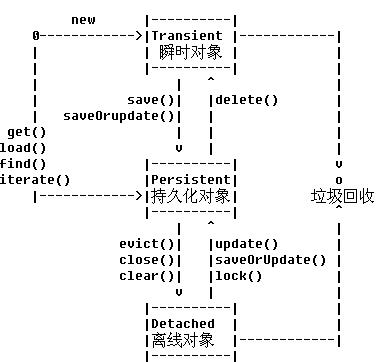hibernate基础-初步
类拟框架:Apache OJB,JDO,Toplink,EJB(CMP)JPA,IBatis
适合查询及单个对象的编辑,适合于对象之间有清晰的关系,不适用于批量修改,关系复杂的对象及特定的sql功能
第一个项目
1 新建java项目
2 创建User Library,加入如下jar
* hibernate_home/hibernate3.jar
* hibernate_home/lib/*.jar
* MySql jdbc验动
3 创建hibernate配置文件hibernate.cfg.xml,为了便于调试最好加入log4j配置文件
 <
hibernate-configuration
>
<
hibernate-configuration
>
 <
session-factory
>
<
session-factory
>
 <!--
连接串
-->
<!--
连接串
-->
 <
property
name
="hibernate.connection.url"
>
jdbc:mysql://localhost/hibernate1
</
property
>
<
property
name
="hibernate.connection.url"
>
jdbc:mysql://localhost/hibernate1
</
property
>
 <!--
驱动类
-->
<!--
驱动类
-->
 <
property
name
="hibernate.connection.driver_class"
>
com.mysql.jdbc.Driver
</
property
>
<
property
name
="hibernate.connection.driver_class"
>
com.mysql.jdbc.Driver
</
property
>
 <!--
用户名
-->
<!--
用户名
-->
 <
property
name
="hibernate.connection.username"
>
root
</
property
>
<
property
name
="hibernate.connection.username"
>
root
</
property
>
 <!--
密码
-->
<!--
密码
-->
 <
property
name
="hibernate.connection.password"
>
root
</
property
>
<
property
name
="hibernate.connection.password"
>
root
</
property
>
 <!--
适配器(反译)
-->
<!--
适配器(反译)
-->
 <
property
name
="hibernate.dialect"
>
org.hibernate.dialect.MySQLDialect
</
property
>
<
property
name
="hibernate.dialect"
>
org.hibernate.dialect.MySQLDialect
</
property
>
 <
property
name
="hibernate.dialect"
>
org.hibernate.dialect.SQLServerDialect
</
property
>
<
property
name
="hibernate.dialect"
>
org.hibernate.dialect.SQLServerDialect
</
property
>
 <!--
显示sql语句
-->
<!--
显示sql语句
-->
 <
property
name
="hibernate.show_sql"
>
true
</
property
>
<
property
name
="hibernate.show_sql"
>
true
</
property
>
 <!--
可以防表被重新建立
-->
<!--
可以防表被重新建立
-->
 <
property
name
="hibernate.hbm2ddl.auto"
>
update
</
property
>
<
property
name
="hibernate.hbm2ddl.auto"
>
update
</
property
>

 <
mapping
resource
="com/myobj/hibername/User.hbm.xml"
/>
<
mapping
resource
="com/myobj/hibername/User.hbm.xml"
/>
 </
session-factory
>
</
session-factory
>
 </
hibernate-configuration
>
</
hibernate-configuration
>
 <
hibernate-mapping
>
<
hibernate-mapping
>
 <
class
name
="com.myobj.hibername.User"
table
=""
>
<
class
name
="com.myobj.hibername.User"
table
=""
>
 <
id
name
="id"
>
<
id
name
="id"
>
 <
generator
class
="uuid"
/>
<
generator
class
="uuid"
/>
 <
generator
class
="native"
/>
<
generator
class
="native"
/>
 <
generator
class
="assigned"
/>
<
generator
class
="assigned"
/>
 </
id
>
</
id
>
 <
property
name
="name"
/>
<
property
name
="name"
/>
 <
property
name
="password"
/>
<
property
name
="password"
/>
 <
property
name
="createTime"
/>
<
property
name
="createTime"
/>
 <
property
name
="expireTime"
/>
<
property
name
="expireTime"
/>
 </
class
>
</
class
>
 </
hibernate-mapping
>
6 将User.hbm.xml文件加入到hibernate.cfg.xml文件中
</
hibernate-mapping
>
6 将User.hbm.xml文件加入到hibernate.cfg.xml文件中
 <
session-factory
>
<
session-factory
>
 <
property
name
="hibernate.connection.url"
>
jdbc:mysql://localhost/hibernate1
</
property
>
<
property
name
="hibernate.connection.url"
>
jdbc:mysql://localhost/hibernate1
</
property
>
 <
property
name
="hibernate.connection.driver_class"
>
com.mysql.jdbc.Driver
</
property
>
<
property
name
="hibernate.connection.driver_class"
>
com.mysql.jdbc.Driver
</
property
>
 <
property
name
="hibernate.connection.username"
>
root
</
property
>
<
property
name
="hibernate.connection.username"
>
root
</
property
>
 <
property
name
="hibernate.connection.password"
>
root
</
property
>
<
property
name
="hibernate.connection.password"
>
root
</
property
>
 <
property
name
="hibernate.dialect"
>
org.hibernate.dialect.MySQLDialect
</
property
>
<
property
name
="hibernate.dialect"
>
org.hibernate.dialect.MySQLDialect
</
property
>

 <
mapping
resource
="com/myobj/hibername/User.hbm.xml"
/>
<
mapping
resource
="com/myobj/hibername/User.hbm.xml"
/>
 </
session-factory
>
7 编写hbm2ddl工具类,将实体类生成数据库表,手工建数据库
</
session-factory
>
7 编写hbm2ddl工具类,将实体类生成数据库表,手工建数据库
 public
class
ExportDB
{
public
class
ExportDB
{
 public static void main(String[] args) {
public static void main(String[] args) {
 //读取hibernate.cfg.xml文件,默认为.properties文件,
//读取hibernate.cfg.xml文件,默认为.properties文件,
 //读取xml文件用new Configuration().configure()
//读取xml文件用new Configuration().configure()
 Configuration cfg=new Configuration().configure();
Configuration cfg=new Configuration().configure();
 //生成工具类
//生成工具类
 SchemaExport export=new SchemaExport(cfg);
SchemaExport export=new SchemaExport(cfg);
 //生成数据库表
//生成数据库表
 export.create(true, true);
export.create(true, true);
 }
}
 }
8 开发客户端Client类添加数据
}
8 开发客户端Client类添加数据
 public
class
Client
{
public
class
Client
{

 public static void main(String[] args) {
public static void main(String[] args) {
 //读取hibernate.cfg.xml文件
//读取hibernate.cfg.xml文件
 Configuration cfg=new Configuration().configure();
Configuration cfg=new Configuration().configure();
 //创建SessionFactory,与数据库绑定,一个数据库对应一个SessionFactory,与二级缓存相关,为重量级对象,是线程安全的
//创建SessionFactory,与数据库绑定,一个数据库对应一个SessionFactory,与二级缓存相关,为重量级对象,是线程安全的
 SessionFactory factory=cfg.buildSessionFactory();
SessionFactory factory=cfg.buildSessionFactory();
 //
//
 Session session=null;//不同于connction,是对其的封装,用时到连接池拿来conn
Session session=null;//不同于connction,是对其的封装,用时到连接池拿来conn

 try {
try {
 session = factory.openSession();
session = factory.openSession();
 //开启事务
//开启事务
 session.beginTransaction();
session.beginTransaction();

 User user = new User();
User user = new User();
 user.setName("张三");
user.setName("张三");
 user.setPassword("123");
user.setPassword("123");
 user.setCreateTime(new Date());
user.setCreateTime(new Date());
 user.setExpireTime(new Date());
user.setExpireTime(new Date());
 //保存数据
//保存数据
 session.save(user);
session.save(user);
 //提交事务
//提交事务
 session.getTransaction().commit();
session.getTransaction().commit();
 } catch (Exception e) {
} catch (Exception e) {
 e.printStackTrace();
e.printStackTrace();
 //回滚事务
//回滚事务
 session.getTransaction().rollback();
session.getTransaction().rollback();
 }finally{
}finally{
 if(session!=null){
if(session!=null){
 if(session.isOpen()){
if(session.isOpen()){
 //关闭session,是非线程安程的
//关闭session,是非线程安程的
 session.close();
session.close();
 }
}
 }
}
 }
}
 }
}
 }
******session.update()相关类都改,session.merge()只改当前类,session.delete(),都要开启事务******
}
******session.update()相关类都改,session.merge()只改当前类,session.delete(),都要开启事务******
9 为了方便跟踪SQL执行,在hibernate.cfg.xml中加入
<property name="hibernate.show_sql">true</property>
创建HibernateUtils类,对重量级容量进行优化:
 public
class
HibernateUtils
{
public
class
HibernateUtils
{
 private static SessionFactory factory;
private static SessionFactory factory;
 //static块只执行一次
//static块只执行一次
 static{
static{
 try {
try {
 Configuration cfg = new Configuration().configure();
Configuration cfg = new Configuration().configure();
 } catch (Exception e) {
} catch (Exception e) {
 e.printStackTrace();
e.printStackTrace();
 }
}
 }
}

 public static SessionFactory getSessionFactory(){
public static SessionFactory getSessionFactory(){
 return factory;
return factory;
 }
}

 public static Session getSession(){
public static Session getSession(){
 return factory.openSession();
return factory.openSession();
 }
}

 public static void closeSession(Session session){
public static void closeSession(Session session){
 if(session!=null){
if(session!=null){
 if(session.isOpen()){
if(session.isOpen()){
 session.close();
session.close();
 }
}
 }
}
 }
}
 }
}
Session接口的CRUD操作
瞬时/持久化/离线对象示例:
 public
class
SessionTest
extends
TestCase
{
public
class
SessionTest
extends
TestCase
{
 public void testSave1(){
public void testSave1(){
 Session session=null;
Session session=null;
 Transaction tx=null;
Transaction tx=null;
 User user=null;
User user=null;
 try{
try{
 session=HibernateUtils.getSession();
session=HibernateUtils.getSession();

 tx=session.beginTransaction();
tx=session.beginTransaction();
 //Transient状态,未被Session管理
//Transient状态,未被Session管理
 user=new User();
user=new User();
 user.setName("ssssss");
user.setName("ssssss");
 user.setPassword("123");
user.setPassword("123");
 user.setCreateTime(new Date());
user.setCreateTime(new Date());
 user.setExpireTime(new Date());
user.setExpireTime(new Date());
 //persistent状态,被Session管理,当属性发生改变的时候,hibernate会自动和数据库同步。
//persistent状态,被Session管理,当属性发生改变的时候,hibernate会自动和数据库同步。
 session.save(user);
session.save(user);

 user.setName("王五");
user.setName("王五");
 tx.commit();
tx.commit();
 }catch(Exception e){
}catch(Exception e){
 e.printStackTrace();
e.printStackTrace();
 tx.rollback();
tx.rollback();
 }finally{
}finally{
 HibernateUtils.closeSession(session);
HibernateUtils.closeSession(session);
 }
}
 //detached状态,被Session踢出缓存,未被管理
//detached状态,被Session踢出缓存,未被管理
 user.setName("张三");
user.setName("张三");
 try {
try {
 session = HibernateUtils.getSession();
session = HibernateUtils.getSession();
 session.beginTransaction();
session.beginTransaction();
 session.update(user);
session.update(user);
 session.getTransaction().commit();
session.getTransaction().commit();
 } catch (Exception e) {
} catch (Exception e) {
 e.printStackTrace();
e.printStackTrace();
 session.getTransaction().rollback();
session.getTransaction().rollback();
 }finally{
}finally{
 HibernateUtils.closeSession(session);
HibernateUtils.closeSession(session);
 }
}
 }
}
 }
}
 //
get查询数据
//
get查询数据
 public
void
testReadByGetMethod1()
{
public
void
testReadByGetMethod1()
{
 Session session=null;
Session session=null;
 try {
try {
 session=HibernateUtils.getSession();
session=HibernateUtils.getSession();
 session.beginTransaction();
session.beginTransaction();
 //采用get方式,马上发出查询sql,加载波User对象
//采用get方式,马上发出查询sql,加载波User对象
 User user=(User)session.get(User.class, "5c68c3ed206a327d01206a3281fa0001");
User user=(User)session.get(User.class, "5c68c3ed206a327d01206a3281fa0001");
![]() http://www.blogjava.net/Images/OutliningIn
http://www.blogjava.net/Images/OutliningIn
适合查询及单个对象的编辑,适合于对象之间有清晰的关系,不适用于批量修改,关系复杂的对象及特定的sql功能
第一个项目
1 新建java项目
2 创建User Library,加入如下jar
* hibernate_home/hibernate3.jar
* hibernate_home/lib/*.jar
* MySql jdbc验动
3 创建hibernate配置文件hibernate.cfg.xml,为了便于调试最好加入log4j配置文件
4 定义实体类,继承java.io.ser
5 定义User类的映射文件User.hbm.xml
9 为了方便跟踪SQL执行,在hibernate.cfg.xml中加入
<property name="hibernate.show_sql">true</property>
持久化对象的状态
1 瞬时对象:使用new操作符初始化的对象不是立刻就持久的。
2 持久化对象:持久实例是任何具有数据库标识的实便函。
3 离线对象:Session关闭后持久化对象就变为离线对名象。
持久化对象的生命周期:
Transient对象new但在数据库中没有记录且没有被Session管理,
Persistent对象数据库中有记录,并Session在管理。在清理缓存(或脏数据检查)时与数据库同步。Session与一级缓存绑定.
Detached对象数据库中有记录,Session没有管理它。
创建HibernateUtils类,对重量级容量进行优化:
Session接口的CRUD操作
瞬时/持久化/离线对象示例:
Session接口
加载数据get与load的区别:
lazy代理:get没有, load支持lazy;
查不存在数据:get返回null,load抛出异常ObjectNotFoundException



评论